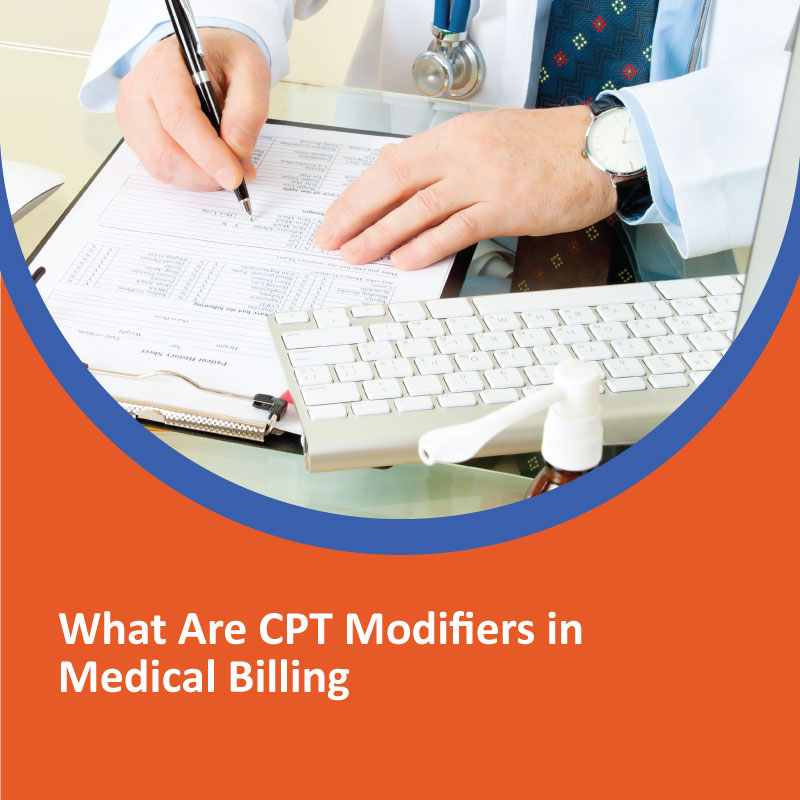In medical billing, details matter. One essential detail is the CPT Modifier—a small addition to a procedure code that can make a big difference. These modifiers are essential for medical billing accuracy and help healthcare providers explain specific situations to insurance companies.
Understanding CPT Modifiers
So, what exactly are CPT Modifiers? Simply put, they’re two-character codes added to a main CPT (Current Procedural Terminology) code. This small addition adds context like if a procedure was unique, had special circumstances, or required extra work.
How CPT Modifiers Work
CPT codes alone describe the primary service provided. However, CPT modifiers add clarity. They tell insurers if the procedure had extra steps, occurred on a specific body part, or needed adjustments.
CPT Modifiers List
Here’s a quick look at some common CPT modifiers:
- Modifier 25 – Used for an additional, separate service on the same day.
- Modifier 50 – Indicates a procedure done on both sides of the body.
- Modifier 59 – This shows that the two services were distinct and separate.
- Modifier 76 – Repeats a procedure by the same doctor on the same day.
This list only scratches the surface—there are dozens more CPT modifiers for various billing needs.
Types of CPT Modifiers
CPT modifiers can be grouped based on purpose:
Modifiers for Services and Procedures:
For additional procedures, like repeat services or bilateral procedures.
Modifiers for Surgery and Anesthesia:
For specific surgical situations and anaesthesia needs.
Payment-Related Modifiers:
Designed to clarify reimbursement requirements and influence payment.
How to Use CPT Modifiers
Using CPT modifiers takes a little practice. Here’s a basic guide:
- Identify the main procedure code.
- Determine if the situation requires additional detail.
- Add the correct modifier that best describes the service provided.
Accuracy is key! Each modifier should correctly describe the situation.
CPT Modifier Examples
Let’s walk through a few examples:
- Example 1: A patient has two unrelated services during one visit. Modifier 25 is added to indicate a separate, significant service.
- Example 2: A procedure is repeated. Modifier 76 clarifies that the service was performed twice.
Real-life examples like these help ensure billing accuracy.
Common CPT Modifiers
To make things easier, here are explanations for some of the most frequent CPT modifiers:
- Modifier 25: Significant, separate evaluation during the same visit.
- Modifier 50: A bilateral procedure, meaning it was performed on both sides.
- Modifier 59: Marks distinct procedures performed on the same day.
- Modifier 76: Identifies repeated services.
Medical Billing Modifiers and Their Significance
Modifiers matter because they impact insurance claims. Properly using modifiers helps get claims approved faster, reduces rejections, and provides clarity for insurers.
Challenges in Using CPT Modifiers
Mistakes with CPT modifiers can lead to rejections or even fraud accusations. Here are common errors:
- Wrong modifier choice.
- Overuse of certain modifiers.
Being familiar with each modifier’s purpose is key to avoiding these issues.
Why CPT Modifiers Matter in Reimbursement
Modifiers directly affect reimbursement. When used correctly, they provide insurers with a clearer picture, increasing the chance of full, timely payment.
CPT Coding Modifiers in Different Specialties
Different specialties often rely on specific modifiers:
- Orthopedics: Uses modifiers for surgeries and repeat imaging.
- Radiology: Often uses modifiers to clarify imaging techniques.
- General Practice: Uses a wide range for various office visits.
Benefits of Understanding CPT Modifiers
Understanding CPT Modifiers is crucial in medical billing. Here’s why mastering them can benefit healthcare providers and billing teams alike:
Increased Billing Accuracy
CPT modifiers help ensure that each service billed is precise. Adding context to CPT codes means fewer errors, less need for re-submission, and greater trust from payers.
Reduced Claim Denials
Claim denials often stem from incorrect or missing modifiers. By using the right CPT modifiers, billers clarify services, reducing denials and speeding up reimbursement. This saves time and improves payment efficiency.
Improved Reimbursement Rates
Applying the correct modifier, like Modifier 22 for complex procedures, signals the need for higher payment. This ensures providers are compensated fairly, maximizing revenue for the practice.
Time Efficiency in Billing
Correct use of modifiers cuts down on rejected claims and follow-up calls. With fewer errors, billing teams can process more claims faster, enhancing overall workflow and reducing administrative strain.
Enhanced Communication with Insurers
Modifiers serve as a bridge, helping insurers understand the specific conditions of each procedure. This open communication reduces disputes and fosters smoother billing processes.
Best Practices for Using CPT Modifiers
Want to master CPT modifiers? Here are some tips:
- Double-check each modifier before submission.
- Train your staff to understand modifiers.
- Stay updated on modifier changes and guidelines.
Conclusion
CPT modifiers are small but mighty tools in medical billing. They ensure procedures are billed correctly, making it easier to get paid on time and accurately. By understanding and using these modifiers correctly, healthcare providers can avoid rejections and simplify the billing process.
Frequently Asked Questions
Q1. What are CPT Modifiers in simple terms?
CPT Modifiers are codes added to CPT codes to give more detail about a procedure.
Q2. How can I learn to use CPT modifiers correctly?
Practice and training are key! Resources like coding courses and workshops can help.
Q3. Are CPT modifiers the same in all specialties?
No, different specialties may use specific modifiers more often.
Q4. What’s the risk of using incorrect CPT modifiers?
Incorrect modifiers can lead to claim denials or even compliance issues.
Q5. Where can I find a full CPT modifiers list?
The full list is available from coding organizations like the AMA (American Medical Association).



